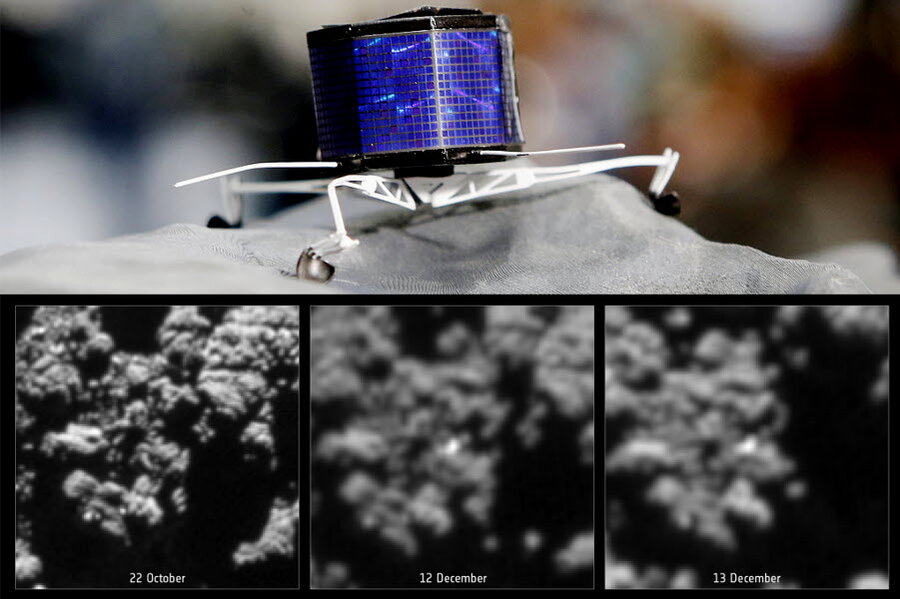Have scientists found the little lost comet lander Philae?
Loading...
On Nov. 12, 2014, millions of people around the world (including at least one cartoonist) held their breath as the European Space Agency tried to land on a comet's nucleus.
The lander, named Philae, launched successfully from the Rosetta orbiter and made it down to the comet surface, where its harpoons failed to fire into the comet. Instead of latching on like a burr, Philae bounced and tumbled its way across the surface of Comet 67P/Churyumov-Gerasimenko.
The lander's final resting spot may now have been identified, according to the mission blog. Images of the comet's surface taken a month after the landing show a bright spot – possibly a glint of sunlight off Philae's solar panels – near an ellipse ESA scientists have calculated as the area Philae is most likely to have reached.
During Philae's bumpy path across the comet's surface, it bounced so high that scientists worried it would escape Churyumov-Gerasimenko's gravity and tumble out into space.
After a hang time of over an hour, Philae fell back onto the comet surface, eventually rolling to a stop near a cliff face, more than half a mile from the initial landing site. The deeply shadowed lander could not get enough sunlight to recharge its solar batteries, so mission scientists raced against time to gather as much information as possible before the batteries died. About 57 hours after making contact with the comet's surface, Philae's mission ground to a halt.
While many were disappointed, mission scientists pointed out that Philae had accomplished the nearly impossible feat of landing on a comet, and then gathered incomparable data, successfully deploying all nine onboard instruments. “This machine performed magnificently under tough conditions, and we can be fully proud of the incredible scientific success Philae has delivered,” blogged Stephan Ulamec, the mission's lander manager.
How did ESA scientists search for the little lost lander?
For weeks, researchers used the OSIRIS imaging system on Rosetta, scouring each new image of the comet.
In mid-December, Rosetta swung close to the comet – only about 11 miles (18 km) above the surface – and took narrow-angle photos, with a resolution of about a foot (34 cm) per pixel. As Philae is only about 3 feet across, with slim 5-foot long legs, scientists were scouring for a bright spot no more than a few pixels across.
The ESA team found five possibilities, but couldn't rule any out without further information.
Fortunately, they had some. They analyzed the travel time of the CONSERT radio signals sent between Philae and Rosetta during Philae's two-hour bounce across the comet's surface, then factored in Rosetta's own trajectory during that time and the topography of the comet. That generated a "best estimate" landing ellipse roughly 50 x 500 feet in size. None of the five bright spots are within the ellipse, but one is close by.
Close may be good enough. As the ESA blog explains, "The location of the ellipse ... depends on the assumed shape model of the comet: as this is constantly being refined, some slight revisions in the positioning of the ellipse remain possible."
The OSIRIS imaging team has also identified some other possible bright spots, "both inside the CONSERT region of interest and nearby,” says Holger Sierks, OSIRIS principal investigator.
He notes that because of Rosetta's orbit and orientation during the December pass, “Philae’s solar panels could have been well illuminated, but still hidden in the rugged terrain from Rosetta’s perspective, making it difficult or impossible to spot.”
In their ongoing search, ESA scientists are focusing on "before and after" shots, places imaged under similar lighting conditions before and after Philae's arrival. They found one very promising candidate that appears in two photos taken on Dec. 12 and 13, but is missing from an Oct. 22 shot of the same area.
“Although the pre- and post-landing images were taken at different spatial resolutions, local topographic details match well, except for one bright spot present on post-landing images” says Philippe Lamy, member of the OSIRIS team at Marseille's Astrophysics Laboratory, in the ESA blog. “This bright spot is visible on two different images taken in December 2014, clearly indicating that it is a real feature on the surface of the comet, not a detector artifact or moving foreground dust speck.”
But none of that is enough to make an official "Yes! We found it!" announcement, the team cautions. This candidate spot is a little outside the ellipse, though that may not be a deal-breaker, plus the almost two-month lag time between the images means that something else could have caused the bright spot, like material burning off the comet nucleus and revealing something brighter below.
For final confirmation, they say, we either need Philae to catch enough rays to wake up and tell us where it is, or we need to wait until next spring when Comet 67P/Churyumov-Gerasimenko finishes looping around the sun and allows a safe, close approach for Rosetta, still in orbit.
“Accurately locating the lander is of great scientific value," says Matt Taylor, ESA’s Rosetta project scientist. "Knowing where Philae is would provide important context for the lander measurements and valuable information for its possible future operation. In the meantime, Rosetta is continuing to observe the comet from a range of distances as the comet’s activity increases.”








